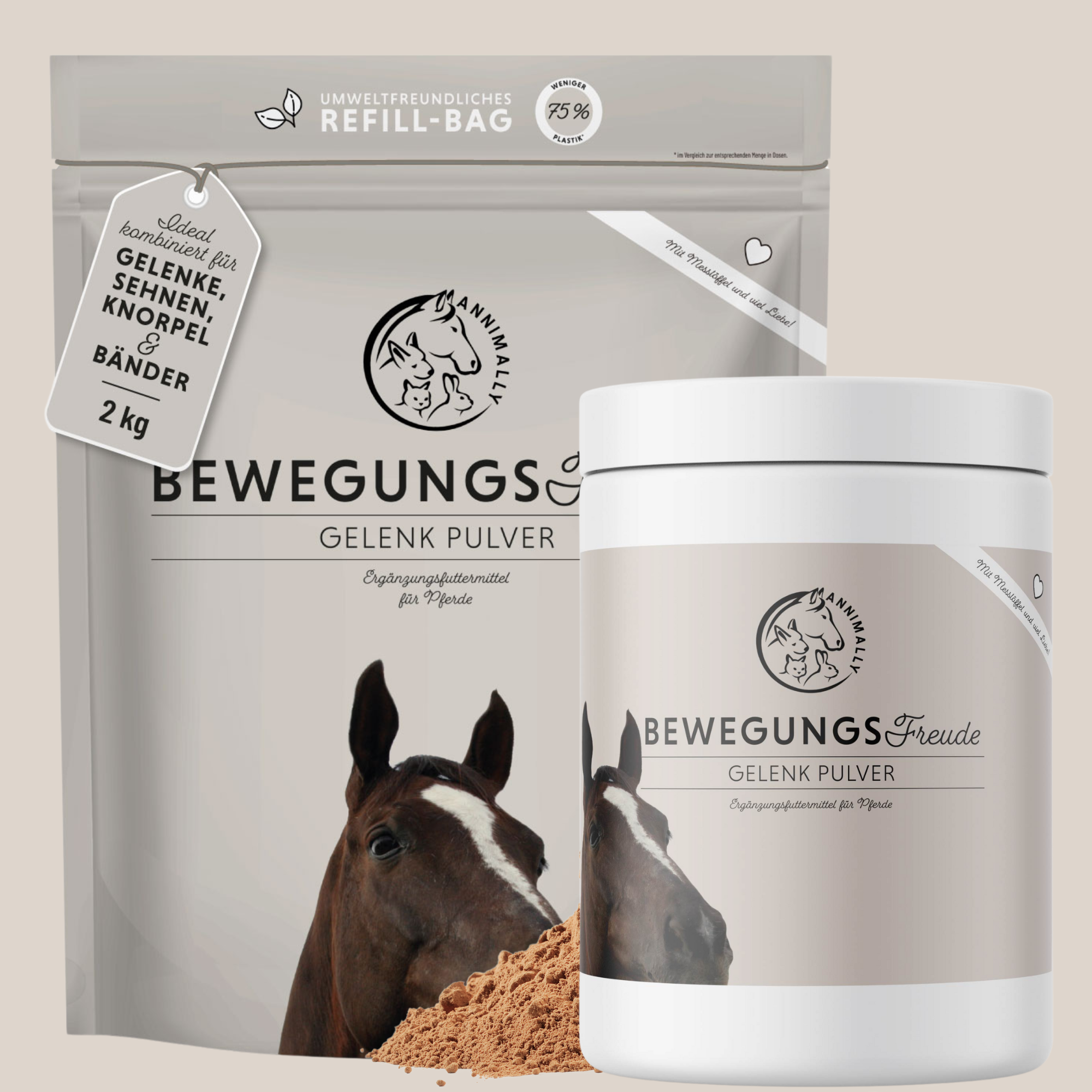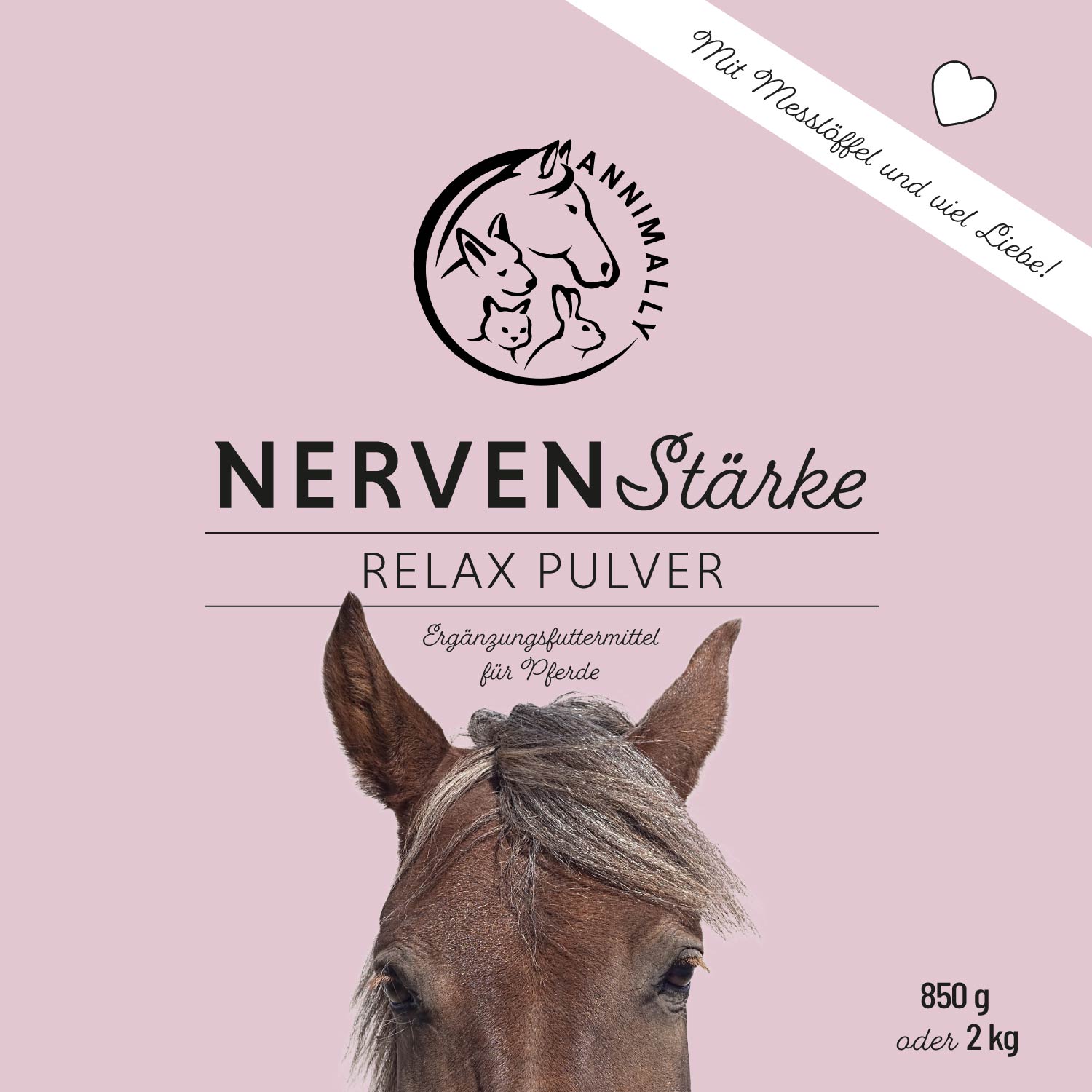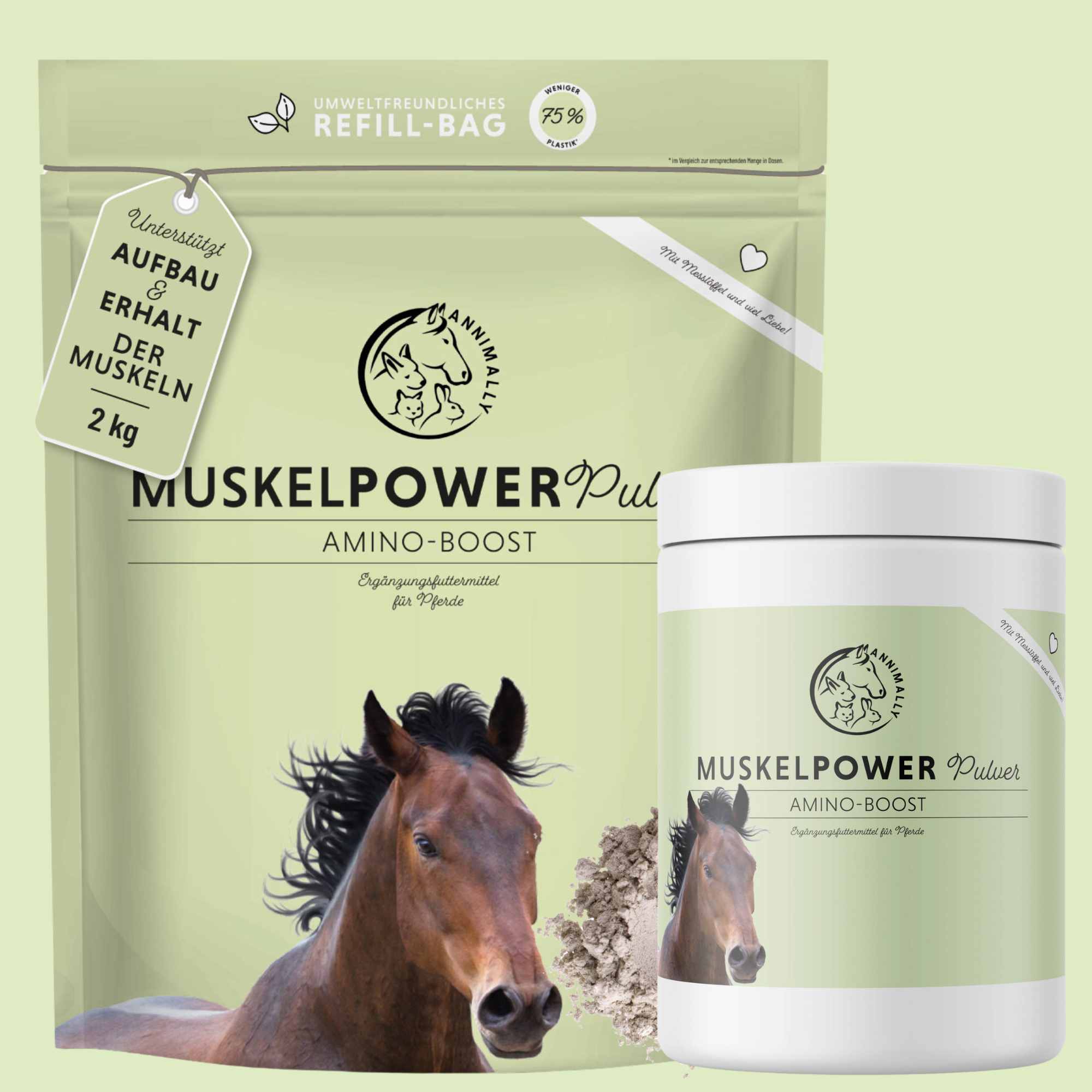
Muscle building horse - feed selection and targeted training
520 different muscles make up over 50% of your horse's total weight - without muscles, nothing works. But how can you support your horse, build up muscles in a targeted way and how do nutrition, exercise and training combine to build up muscles?
Muscles - this is what they are responsible for

Without muscle power there would be no step forward, no jumping over obstacles, no dressage lesson and also no ride across meadows and fields.
A well-built musculature is important for your joint training, but above all for the health of your four-legged friend. Without the right muscle development, there can be no problem-free movement. In the worst case, your horse will walk stiffly or injure itself if there are not enough muscles. Therefore, proper muscle development is an absolute must for every horse.
Horse musculature
Your horse has almost 520 different muscles. They are distributed among different muscle groups: Cardiac muscles, smooth muscles and skeletal muscles. The heart muscles are responsible for the horse's entire circulation and pump up to 180 litres of blood per minute through the horse's body. The smooth musculature is also called visceral musculature and is located on the internal organs or blood vessels. The skeletal muscles are responsible for motor function. When we talk about muscle building in horses, we are therefore looking at the skeletal muscles.
Muscle building - what do you look out for?

Horse muscles need exercise, properly balanced feed and a good training plan.
Three building blocks are crucial when it comes to healthy muscle development in horses: exercise, targeted training and a suitable diet. The most important factor, however, is time. We know this ourselves, just because we do sit-ups and drink protein shakes for a fortnight doesn't mean we have a six-pack. Building muscle takes time and should not be done too quickly, because that can also be harmful. Besides the muscles, tendons and ligaments also have to keep up with the development. If you plan for little time and quick successes, you will harm your horse. If you adjust the individual components to the individual needs of your horse, nothing will stand in the way of long-term and healthy muscle development. Does your horse have certain pre-existing conditions or injuries, or are you unsure about the composition of the feed or training plan? Please get your vet and trainer on board!
Nutrition for building muscle

In order for your horse's muscles to grow, you need the right feed and optionally supplements. A combination of roughage, concentrated feed and supplementary feed helps your horse to develop muscles. We have summarised the essential components of horse nutrition for muscle development.
Roughage, concentrated feed, supplementary feed
The basis for a balanced diet is roughage. This should ideally be available throughout the day or fed over the course of the day. With high-quality roughage, your horse absorbs valuable raw fibres that ensure good digestion. The right quality is an absolute must! Without power there are no muscles. Especially during training, the energy balance can be covered very well by so-called concentrated feed. In addition to roughage and concentrated feed, your horse also needs vitamins, trace elements and minerals. While salts and minerals are useful for all horses, a horse in muscle development needs additional vital substances. This is contained in special supplementary feed. With our Biotin Liquid you can support your darling with all the necessary vitamins and minerals in muscle building.
Carbohydrates
In order for your horse's muscles to work at all, they need carbohydrates. A large part is already covered by the roughage. Depending on the intensity of the training, a carbohydrate supplement is also necessary and useful.
Protein and amino acids
A sufficient amount of protein in the feed is an important building block for the development of muscles. Proteins should therefore be included in your horse's diet in sufficient quantities - and on a daily basis, as proteins cannot be stored but must always be available. Amino acids are considered the building blocks of proteins and are necessary to build muscles. Essential amino acids in particular belong in a good supplementary feed, because they
cannot be produced by horses themselves. Essential amino acids include, for example, leucine, lysine, methionine, valine, isoleucine and histidine.
Oil for endurance
The type of energy sources fed also depends on the form in which horses need to retrieve their energy. In endurance sports, energy has to be available over a longer period of time, and oil is a suitable supplement for this. As horses do not have a gall bladder, the oil must be easily digestible and fed in small quantities throughout the day. This way, your four-legged friend can digest the oil well and make the best possible use of the energy. Only use high-quality oils such as linseed oil, sunflower oil or maize germ oil. In the long term, you should not feed more than 500 ml per day, otherwise it can damage the liver and intestines.
Sugar and starch for racehorses
Especially for athletes among horses, sugar and starch are also suitable energy suppliers. If energy has to be called up very quickly, as is the case with racehorses, energy in the form of sugar and starch is very suitable. This form of carbohydrate is directly available and boosts your four-legged friend.
Normal movement is important for the muscles

Besides specific training exercises, your horse should get enough normal exercise. Normal movement is also necessary if muscles are to grow in a healthy way. Full power in training always leads to overload and tension. Depending on the type of husbandry, everyday exercise is also necessary for planning your feeding. If your horse has already taken in fresh grass on the pasture or has had a lot of exercise in the open stable, you should take this into account in the feed plan.
Training - variety and many breaks
Targeted training is necessary for muscles to grow. In addition to sufficient exercise, transitions, pole work, lateral gaits and stretching exercises are good ways to build muscle and especially strengthen the back muscles.
Muscle development in horses - how long does it take?
How long you need to build up the muscles depends on your horse, the current level of training and your goals. If your horse has just come out of an injury break, you will need a few months to get back to the training level before the break. If your horse is already well trained and you want to work specifically on some muscle groups, you will see quicker results. However, the speed at which the horse's muscles are built up also depends on the horse's general state of health and age. It is better to focus on long-term and healthy muscle development than on quick successes! This is more sustainable and healthier for your friend on four hooves.
Training, training, training - to the muscle limit

Targeted training is necessary for muscles to grow. In addition to sufficient exercise, transitions and pole work are good ways to build muscle and especially strengthen the back muscles. Always include a stretching session as well. Just like with humans, healthy muscle building only works with sufficient stretching before and after training.
Special case of injury break

If your horse starts to build muscle again due to an injury, please get your veterinarian on board. Depending on the type of injury and the duration of the break, a specific training plan should be followed. This will also include a specific feeding plan. If your horse has been prescribed absolute box rest and the musculature has degenerated considerably, you cannot work directly with transitions or cavaletti. In the worst case, you will overstrain your horse and damage the already degenerated muscles. It is best to talk to your vet before you simply start training or feeding.
Muscle growth during training
For muscles to grow, they need a training stimulus. This signals to the muscle that it needs to grow. A training stimulus is reached when the performance limit of a muscle is reached or exceeded a little bit. Small stimuli in different exercises stimulate muscle growth. But: breaks between the individual training units are obligatory. Always include a stretching session. Just like with us humans, healthy muscle growth only works with sufficient stretching before and after training and time for regeneration. Here are our tips on what to look out for during training:
Bring variety to the training
In order for the muscles to have time to grow, the individual muscle groups need breaks between targeted training sessions. During these breaks, however, you can train other muscle groups or work on your horse's condition. Plan rides, walks or lunge work between training sessions. Do not train one muscle group too long and too often in a row. The horse's body needs breaks in between to allow the muscles to grow. Train more often in smaller sessions than twice a week for three hours. Allow your four-legged friend regular rest days in the paddock.
Pay attention to your horse's signals
Even with a great training plan with variety and easier walks, you should always listen to your horse. Just like us humans, a horse can also get sore muscles. Does it walk stiffly, doesn't want to be touched in certain places or behaves strangely when preparing for a training session? All these can be signals for a proper muscle ache. For some horses, a suddenly introduced training schedule also leads to stress - training is not only a question of physical fitness, but also of mental fitness. If you have the feeling that your horse might somehow reach its limits, plan a break day or a relaxing walk.
Don't underestimate the walk
When you think of muscle building, you probably immediately think of trot-canter transitions and difficult lessons with poles and cavalettis. First of all, however, muscle building begins with the walk. Without transitions, without bends, first straight ahead, forward-downward. This way you strengthen your horse's condition and make sure that all muscle groups are used and warmed up at the walk. A warm-up phase at a walk is the basis for every(!) training session anyway.
Transitions
Transitions work wonders for building muscle. Make sure that your horse moves forward and downward and that the transitions come from the hindquarters. Your horse should not simply continue to lope along at a faster gait. With transitions from the hindquarters you train your horse's back and abdominal muscles. In the beginning, only use simple transitions such as walk-trot or trot-canter transitions to build up the muscles in a healthy and long-term way.
Reverse, bend and place
To build up muscles, you can also teach your horse backward training and bending. Always make sure that your horse is in the correct position. If your horse pulls up its head when backing up or jumps over its shoulder when bending, you must first correct the horse's posture.
Sideways steps
When your horse crosses its legs while walking sideways, many muscle groups are active. This way you also train the shoulder muscles and the croup muscle. You can integrate lateral gaits into your training. Make sure that your horse goes sideways evenly and does not run away with the forehand or hindquarters. If you haven't practised so many lateral gaits yet, it's best to start from the ground, so you can control the forehand and hindquarters even better. Start with correctly executed small, clean movements. Fast and unclean sideways walking is useless and only leads to stress.
Use hills or climbs
Do you have hills in the countryside? Then you have another great opportunity to do something for your four-legged friend's muscles during a ride. Your horse has to use its muscles especially when going uphill or downhill in order to move forward. This way, you train your horse's back and hindquarters in particular.
Groundwork
Besides intensive training under the saddle, you can also achieve a lot with ground work. With ground work you also strengthen the bond with your horse and you refine the joint communication. You can also try out new exercises on the ground first, so you can give your horse even more security and try out exercises without rider weight.
Polework

Feet up - there's something there. When working with poles, your horse has to lift its hooves a little higher than normal to get over the pole. This is a great exercise for the back muscles and also trains your horse's attention. Don't use too many poles at the beginning and make sure you use the right distances in the different gaits.
Work on the lunge

Lunging your horse is also very good for building muscles. The bending activates muscle groups and your horse can work without the rider's weight. This way it learns to balance himself. For the correct posture of your horse, you can also use additional bindings or auxiliary reins. If you haven't had any experience with this yet, let us help you! If the bridle is set too tightly, your horse will walk with the wrong neck posture and you will damage the muscles. Also include hand changes so that your horse can move on both hands. You can also use poles when lunging.
Stretch, stretch, stretch
In order for the muscles to be able to regenerate after training, they need to be stretched. It is therefore essential to plan stretching exercises. These should ideally be done before and after the training phases. You can also incorporate isolated exercises regularly into your horse's daily routine or even during training. Here are two tips for simple stretching exercises:
- Stretch the neck: Slowly let the reins come out of your hand and walk forward with your hands. This way your horse can stretch its neck in between exercises, stretching and snorting. This is also a great reward between exercises.
- Stretch the horse's back and neck: Grab a carrot and stand next to your horse. Slowly put your hand between your favourite's front legs and wait until the horse's nose follows the carrot. Depending on how flexible your horse is, you can go up to the fetlocks or even a little towards the belly. You can also hold the carrot at the level of the shoulders so that your horse has to stretch its neck to the side. Your horse should already be somewhat warmed up for this exercise. Start with small stretches and don't force your horse if he can't do a stretch perfectly. Of course, the carrot is a reward afterwards anyway.
Muscle building - variety, stretching, breaks and the right food
There are numerous ways to train your horse so that his muscles grow. Take your time and focus on fitness, variety and stretching exercises. Don't be overambitious with your training plan and take care of your horse. If you start a very intensive training after a break, you should leave enough time for regeneration in between.
Only use high-quality feed and make sure that your horse receives a sufficient supply of nutrients and vitamins. Especially during muscle building and intensive training phases, your horse needs additional feed so that the muscles can grow.






















